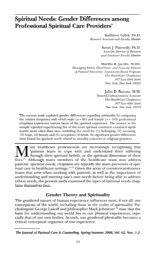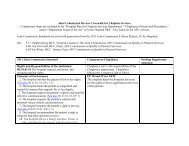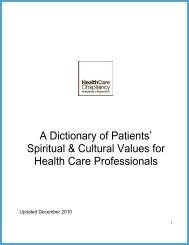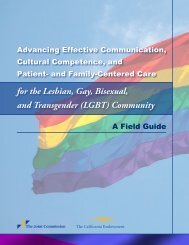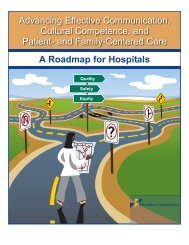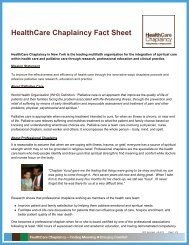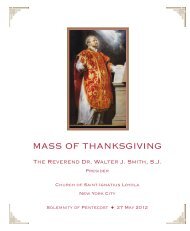Education, Research, Theory, and Practice in Professional Chaplaincy
Education, Research, Theory, and Practice in Professional Chaplaincy
Education, Research, Theory, and Practice in Professional Chaplaincy
You also want an ePaper? Increase the reach of your titles
YUMPU automatically turns print PDFs into web optimized ePapers that Google loves.
Journal of Health Care Chapla<strong>in</strong>cy, 16:1–2, 2010<br />
Copyright # Taylor & Francis Group, LLC<br />
ISSN: 0885-4726 pr<strong>in</strong>t=1528-6916 onl<strong>in</strong>e<br />
DOI: 10.1080/08854721003609444<br />
Editorial<br />
<strong>Education</strong>, <strong>Research</strong>, <strong>Theory</strong>, <strong>and</strong><br />
<strong>Practice</strong> <strong>in</strong> <strong>Professional</strong> Chapla<strong>in</strong>cy<br />
The articles <strong>in</strong> this issue of the Journal of Health Care Chapla<strong>in</strong>cy cover all<br />
the bases that should be addressed <strong>in</strong> a professional journal: education,<br />
research, theory, <strong>and</strong> practice. Moreover, all the articles illustrate, to vary<strong>in</strong>g<br />
degrees, how two or more of these professional pillars relate to one another.<br />
The article by Derrickson <strong>and</strong> Van Hise describes a course for CPE<br />
residents at Penn State Hershey Medical Center <strong>in</strong> which students <strong>in</strong>tegrate<br />
f<strong>in</strong>d<strong>in</strong>gs from published research on different diseases <strong>in</strong>to their own spiritual<br />
assessments of patients, <strong>and</strong> develop cl<strong>in</strong>ical pathways or guidel<strong>in</strong>es<br />
for chapla<strong>in</strong> <strong>in</strong>terventions to meet the spiritual needs of patients with different<br />
health problems. The Journal encourages the submission of articles<br />
about <strong>in</strong>novative curricula <strong>and</strong> educational approaches, especially ones that<br />
provide empirical evidence for their value <strong>and</strong> expla<strong>in</strong> how they can<br />
enhance ‘‘best practices’’ <strong>in</strong> chapla<strong>in</strong>cy.<br />
Of the four research articles <strong>in</strong> this issue, one reports the results of a<br />
survey of professional chapla<strong>in</strong>s, <strong>and</strong> two report the results of studies based<br />
on chapla<strong>in</strong>s’ documentation of their pastoral care activities with hospitalized<br />
patients. One of these is a survey of APC (Association of <strong>Professional</strong><br />
Chapla<strong>in</strong>s) members conducted by Harr, Openshaw, <strong>and</strong> Moore, that exam<strong>in</strong>ed<br />
chapla<strong>in</strong>s’ attitudes about the <strong>in</strong>terdiscipl<strong>in</strong>ary relationship between<br />
chapla<strong>in</strong>s <strong>and</strong> social workers (<strong>and</strong> other professionals to a lesser extent) <strong>in</strong><br />
<strong>in</strong>stitutional sett<strong>in</strong>gs. Underst<strong>and</strong><strong>in</strong>g these <strong>in</strong>terdiscipl<strong>in</strong>ary relationships is<br />
particularly important for chapla<strong>in</strong>s s<strong>in</strong>ce the field appears to be mov<strong>in</strong>g<br />
toward a referral-based model of pastoral care for hospitalized patients.<br />
The two studies based on chapla<strong>in</strong>s’ own documentation of their<br />
pastoral care practices raise some important questions that should be<br />
addressed <strong>in</strong> future research. The study by Galek, Silton, V<strong>and</strong>erwerker,<br />
H<strong>and</strong>zo, Porter, Montonye, <strong>and</strong> Fleenor raises questions about the uniformity<br />
of pastoral care for patients of different religious faiths, by highlight<strong>in</strong>g differences<br />
<strong>in</strong> the use of prayer as an <strong>in</strong>tervention when chapla<strong>in</strong>s <strong>and</strong> patients<br />
belong to the same religion or different religions. The brief report by<br />
Montonye <strong>and</strong> Calderone challenges assumptions about cl<strong>in</strong>ical practice <strong>in</strong><br />
chapla<strong>in</strong>cy <strong>and</strong> the measurement of pastoral care practices. The first concern<br />
it raises is whether chapla<strong>in</strong>s’ assessments <strong>and</strong> <strong>in</strong>terventions reflect the needs<br />
1
2 Editorial<br />
of their patients or <strong>in</strong>dividual differences among chapla<strong>in</strong>s themselves, which<br />
may be rooted <strong>in</strong> their tra<strong>in</strong><strong>in</strong>g <strong>and</strong> education. The second concern, which<br />
falls with<strong>in</strong> the realm of measurement theory, is whether self-report measures<br />
obta<strong>in</strong>ed from chapla<strong>in</strong> are valid <strong>and</strong> reliable. A third concern, which the<br />
study is not able to address, is the degree to which chapla<strong>in</strong>s’ <strong>in</strong>terventions<br />
with patients follow logically from their assessments of patients.<br />
Ai <strong>and</strong> McCormick offer a unique perspective on the professional<br />
practice of chapla<strong>in</strong>cy through their exploration of the ag<strong>in</strong>g of the ‘‘bay<br />
boom’’ generation <strong>and</strong> the diversification of religious faith <strong>in</strong> the United<br />
States, <strong>in</strong>clud<strong>in</strong>g differences <strong>in</strong> afterlife beliefs among religious traditions,<br />
pr<strong>in</strong>cipally: Confucianism <strong>and</strong> Taoism; Buddhism <strong>and</strong> H<strong>in</strong>duism; <strong>and</strong> the<br />
Abrahamic religions – Judaism, Christianity <strong>and</strong> Islam. Differences <strong>and</strong><br />
similarities among these <strong>and</strong> other religious traditions may provide <strong>in</strong>sights<br />
<strong>in</strong>to a possible theoretical framework for chapla<strong>in</strong>cy.<br />
Two articles I would like to mention – one by Mayo <strong>and</strong> the other by<br />
Galek <strong>and</strong> Porter – are brief reports=reviews about the implications of bra<strong>in</strong><br />
research <strong>and</strong> theory on professional chapla<strong>in</strong>cy <strong>and</strong> pastoral care. The brief<br />
review by Mayo gives a concise <strong>and</strong> fasc<strong>in</strong>at<strong>in</strong>g summary of bra<strong>in</strong> research<br />
on mediation <strong>and</strong> anxiety, <strong>and</strong> the long-term effects of meditation on bra<strong>in</strong><br />
function. The ma<strong>in</strong> implication of this research, accord<strong>in</strong>g to the author, is<br />
that spiritual <strong>in</strong>terventions should focus on chang<strong>in</strong>g patients’ attention away<br />
from thoughts about worries <strong>and</strong> concerns, <strong>and</strong> towards peaceful thoughts.<br />
The brief report by Galek <strong>and</strong> Porter presents the f<strong>in</strong>d<strong>in</strong>gs of their study<br />
on the use of measures of religious beliefs <strong>in</strong> mental health research, <strong>and</strong><br />
describes a theoretical model of how religious <strong>and</strong> other beliefs can directly<br />
affect the bra<strong>in</strong> <strong>and</strong> psychiatric symptoms, especially anxiety. The paper<br />
focuses on evolutionary threat assessment theory (ETAS <strong>Theory</strong>) <strong>and</strong><br />
expla<strong>in</strong>s its relevance to the practice of chapla<strong>in</strong>cy.<br />
The Journal of Health Care Chapla<strong>in</strong>cy welcomes <strong>and</strong> encourages the<br />
submission of full-length manuscripts that discuss <strong>and</strong> <strong>in</strong>tegrate the four<br />
pillars of professional chapla<strong>in</strong>cy, especially practice-focused research,<br />
empirically based articles about educational <strong>and</strong> treatment programs=<br />
<strong>in</strong>terventions, <strong>and</strong> reviews <strong>and</strong> theoretical articles pert<strong>in</strong>ent to chapla<strong>in</strong>cy.<br />
The Journal also welcomes <strong>and</strong> encourages brief, erudite reviews <strong>and</strong><br />
reports on these or other topics <strong>in</strong> religion <strong>and</strong> health that might be of<br />
<strong>in</strong>terest to our readers.<br />
Kev<strong>in</strong> J. Flannelly, Ph.D.<br />
Editor-<strong>in</strong>-Chief



